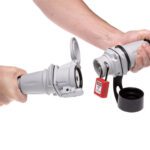Required Skills for the Manufacturing Phase of Connector Development
As part of the Connector Basics series, APEX Electrical Interconnection Consultants have introduced us to the phases of new connector development and defined the skills needed for each. In this installment, Bill Garver and George Bedorf discuss the required skills for the manufacturing phase of connector development.
 In a previous article, it was suggested that to ensure a successful product development and launch, manufacturers need to optimize the talents of their employees to be sure that critical needs are addressed. As outlined, the new product process consists of four specific phases, each requiring specialized skill sets:
In a previous article, it was suggested that to ensure a successful product development and launch, manufacturers need to optimize the talents of their employees to be sure that critical needs are addressed. As outlined, the new product process consists of four specific phases, each requiring specialized skill sets:
- Creative/innovative
- Engineering/scientific
- Implementation/manufacturing
- Release/launch
Here we look at the third of the four phases, implementation/manufacturing, for not only the skills needed but also some tools that may be used to facilitate the process.
Individuals with broad experience in manufacturing and materials management disciplines are needed in this phase. At this point in the process, the product design is well-documented and the detailed drawings completed for the product and tooling. The development team’s activities will emphasize coordination with suppliers of components and finalization of assembly tooling and equipment. The tooling designs will be based upon both the sales forecast and the connector design requirements.
During this phase, initial parts are manufactured from production tooling and finished product is tested, evaluated, and ultimately placed on the shelf for initial release of the product. Connectors that meet all the specified design requirements are manufactured and tested to validate connector performance. Typically, a product performance specification is developed and published after appropriate testing on production parts has been completed.
Often, connector performance problems in customers’ applications are a result of product that was not manufactured to specified design requirements. Manufacturing process validation, which can reduce this risk, demonstrates that processes have the potential (or capability) to consistently produce products that meet specifications and ensures that product design objectives can be achieved. Ideally, this continues throughout the product life cycle. Records of the initial process validation are maintained for future reference.
Process validation actually begins earlier, in the engineering phase of new product development. During the engineering/scientific phase of a new product creation, “design for manufacturing” must be considered. Both product design engineers and manufacturing engineers must concur that a design can meet performance objectives and that it can be consistently manufactured. This is an essential element of risk management during the product design and development process. If a risk assessment determines that necessary manufacturing technologies have not yet been sufficiently developed and verified, then a manufacturing process development project should be undertaken before proceeding with a proposed design.
At the end of process validation, product development team members prepare and review a report that summarizes results. This report validates that in addition to product quality requirements, targets for manufacturing costs and volumes can consistently be achieved.
Materials management, purchasing, and manufacturing personnel play a significant role during this phase. For example, product release lead time is impacted by material and tooling availability. Delay in receipt of only one component can impact the planned market release of the product. It is very helpful to use a Critical Path Method (CPM), such as Program Evaluation and Review Technique (PERT), to manage progress of various activities. CPM identifies the activities that take the longest time. It also identifies which tasks can be delayed if resources need to be reallocated to help get the “overrunning” activities back on schedule. Activities need to be frequently monitored to assess adherence to the scheduled tasks.
The amount of product required to support planned sales (plus initial promotional activity) is decided. Advertising brochures, catalogs, news releases, test reports, etc., are also planned and prepared during this phase in preparation for product release.
To read more articles in this series, click the links below:
- Necessary Skills for New Product Development
- The Creative Phase of New Product Design
- The Engineering Phase of New Product Design
Visit APEX Electrical Interconnection Consultants online.
[hr]
 George Berdorf, principal consultant at APEX Electrical Interconnection Consultants and former director of quality assurance at AMP Incorporated, has more than 30 years in the connector industry. He has expertise in the use of planning and improvement tools to improve both business and manufacturing processes and extensive hands-on experience in the development and implementation of new processes and the introduction of new products into manufacturing.
George Berdorf, principal consultant at APEX Electrical Interconnection Consultants and former director of quality assurance at AMP Incorporated, has more than 30 years in the connector industry. He has expertise in the use of planning and improvement tools to improve both business and manufacturing processes and extensive hands-on experience in the development and implementation of new processes and the introduction of new products into manufacturing.
 Bill Garver, principal consultant at APEX Electrical Interconnection Consultants and former division manager and director of development engineering at AMP, has more than 47 years experience in the connector industry, primarily in the management and direction of new product development and operational division management. He developed new products throughout the full product life cycle, concept through introduction, for industries including consumer, commercial, computer, industrial, communications, and medical.
Bill Garver, principal consultant at APEX Electrical Interconnection Consultants and former division manager and director of development engineering at AMP, has more than 47 years experience in the connector industry, primarily in the management and direction of new product development and operational division management. He developed new products throughout the full product life cycle, concept through introduction, for industries including consumer, commercial, computer, industrial, communications, and medical.







